Emotional marketing is a powerful marketing technique that differentiates highly successful brands from averagely successful ones.
Customers are getting more thoughtful and informed day by day, and it now takes more effort to see customers through to the end of the sales funnel.
Even if you have a good product, the best way to persuade customers is to understand how their emotions decide their purchases.
These emotional marketing statistics will cover:
- Emotional marketing trends
- Benefits of emotional marketing
- Emotional marketing examples
- Importance of emotional marketing
- Emotional marketing effectiveness
- Emotional marketing concept
Ready? Let’s dive in.
12 Interesting Emotional Marketing Statistics
1. Ads with purely emotional content perform twice as well (31% vs. 16%) compare to those with only rational content
Let’s kick off these emotional branding statistics with an analysis of data by IPA (the UK-based Institute of Practitioners in Advertising). IPA researched 1400 case studies of successful ad campaigns intending to know how emotional and rational content impact ads.
The result was clear. Ads with purely emotional perform almost twice as well (31% vs 21%) to those with only rational content.
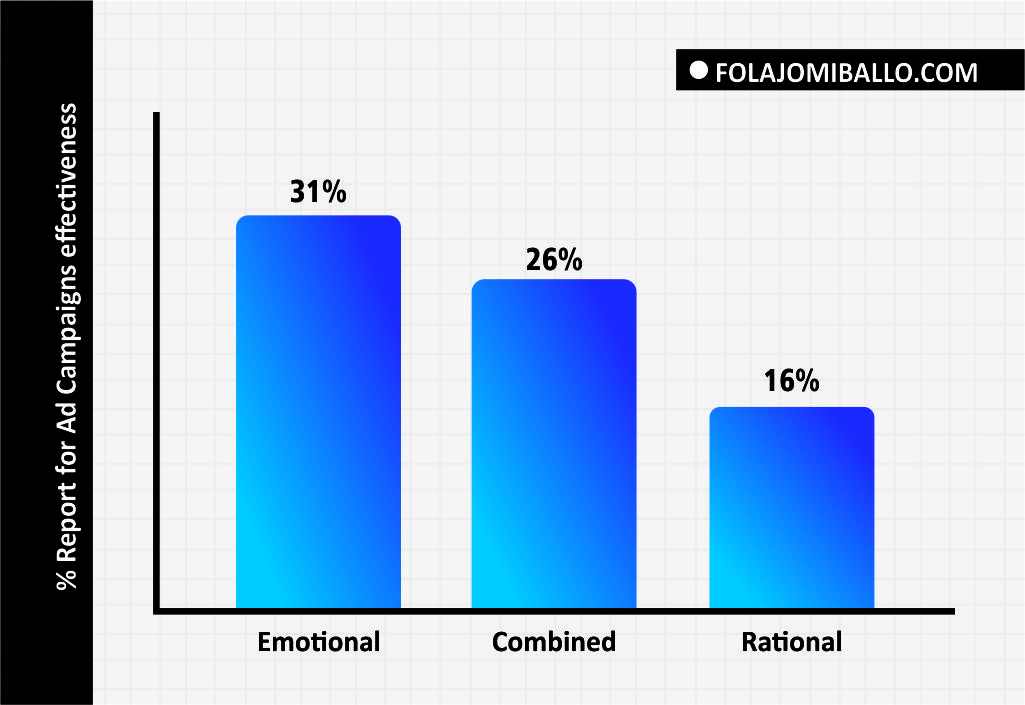
As humans, we are slaves to our emotions. Therefore, marketers creating ads should create emotionally appealing ads rather than just creating rational ads.
2. Content that elicits anger has a 38% chance of going viral
These days, content goes viral pretty fast, and a study has proven that emotions contribute to the virality of content.
According to a study, content that elicits anger has a 38% chance of going viral. These types of content are likely to get more shares as readers will want others to see it.
Before you start doing it wrong, anger here is to be directed to the topic, not making your readers angry by disrespecting or insulting them. Writing about a controversial issue is an excellent example since everyone will have a different opinion.
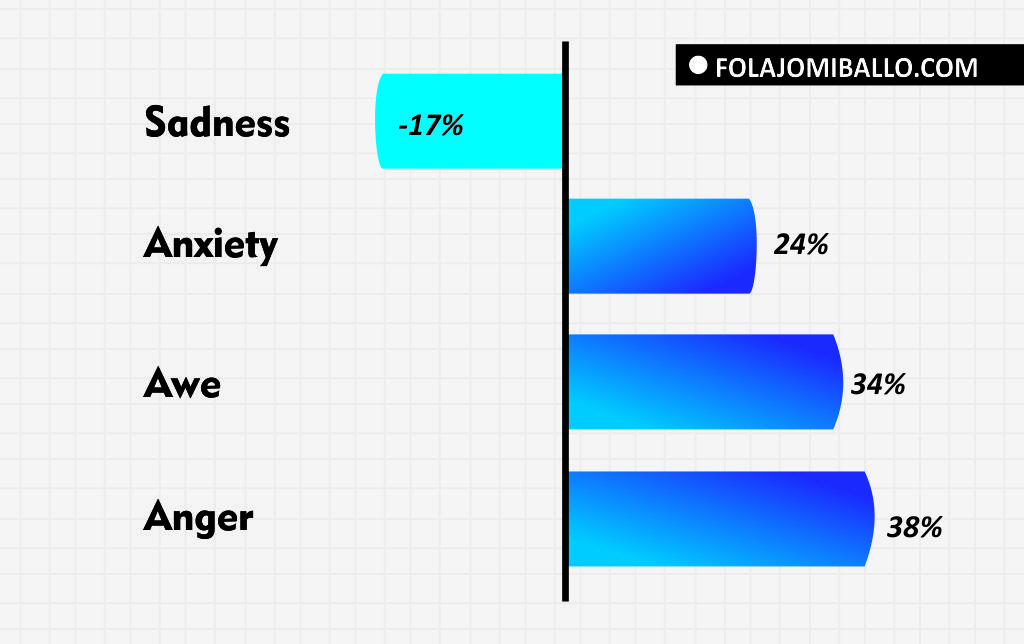
Also, content that awe readers have a 34% chance of going viral, followed by anxiety which has a 24% chance of going viral. Lastly, content that makes readers sad will likely not go viral (-17%). The kind of content that goes viral are those that cause high-energy emotions (anger, awe, anxiety), not those that cause low-energy emotions like sadness.
3. Customers who have an emotional relationship with a brand will likely recommend the company at a rate of 71%
Building emotional connections with customers is the most brilliant marketing strategy any business should learn. It has helped a lot of brands grow their business fast.
According to a study, customers who have an emotional relationship with a brand have a 306% higher lifetime value and will likely recommend the company at a rate of 71%, instead of the average 45%.
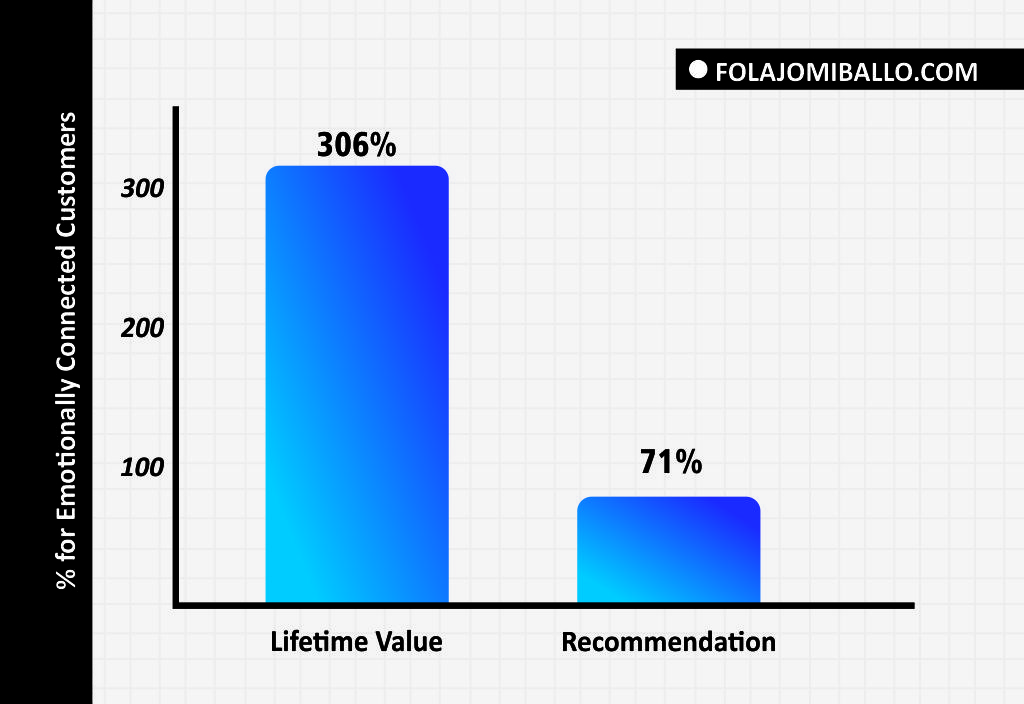
This implies that you can make customers feel committed to your business and recommend you more by connecting with them emotionally. Customers reward brands they are emotionally attached to with their loyalty and even advocacy.
4. Ads with an above-average emotional Response generates a 23% spike in sales volume
Again, emotions are central to advertising. They are the deciding factor whether your ads will convert or not.
Nielsen researched 100 ad copies across 25 brands to know whether emotions affect ad conversions. The result shows that Ads with an above-average emotional Response generates a 23% increase in sales volume.
The study aims to confirm whether our emotions rule the ads we watch. And the result made it clear that, as humans, we are led by our feelings, and so are the ads we watch.
5. Headlines with negative superlatives (“worst” or “never”) have a 30% more Click-through rate than headlines with positive superlatives (“best” or “always”)
This study is surprising. How does the audience respond more to headlines with negative superlatives? Are positive superlatives not the best words to include in our headlines?
Anyway, Outbrain researched 65,000 headlines, and the result was an eye-opener.
Headlines that contain positive superlatives (best or always) perform 29% worse than those containing negative superlatives like worst or never. On the flip side, headlines containing negative superlatives (worst or never) achieve 30% better than those with positive superlatives.
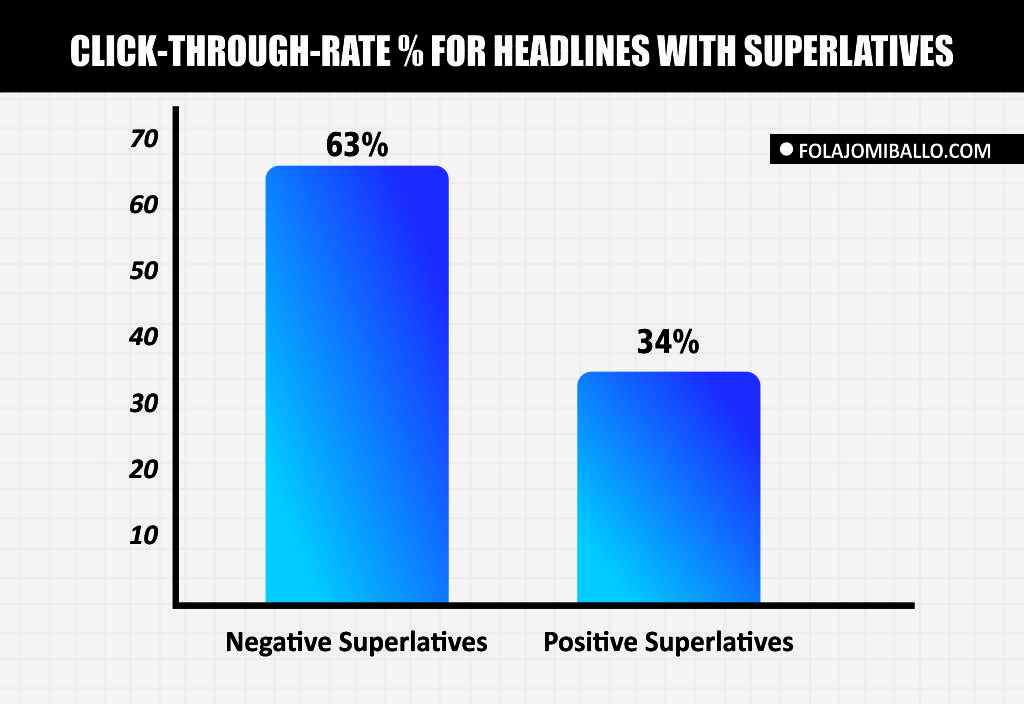
In conclusion, the study acknowledged that the average click-through rate on headlines with negative superlatives is 63% higher than positive superlatives.
Brands should constantly use negative superlatives in their headlines since it can trigger an emotion that will make customers want to click on the headline.
6. Customers who are emotionally connected to a Business are 52% more valuable than the highly satisfied customers
Striking a balance between satisfying customers and emotionally connecting with customers is a real talk for brands. Yet, brands often focus on satisfying customers rather than building an emotional connection with them.
According to a study, Customers who are emotionally connected to a Brand are 52% more valuable than highly satisfied customers. Although, customers are beneficial at every level. But they are more useful when they feel connected to the business.
This study is similar to the emotional marketing stat that says customers who have a passionate relationship with a brand will likely recommend the company at a rate of 71%. So the best way to keep customers and make them valuable for life is by building an emotional relationship with them.
7. Videos that elicit strong emotions are 2X likely to be shared than those that produce a weak emotional response
It’s not surprising that emotions affect the shareability of video content. Who will not want to share a video that lightens up their mood? And who will share a video that ruins their day?
According to Unruly, Videos that elicit strong emotions are twice as likely to be shared than those that produce a weak emotional response. This implies that videos that cause high-energy feelings (happiness, anxiety, etc.) will be more shared than those that cause low-energy emotions (sadness). Also, you can add audio to video to give it a positive effect.
Since video content is highly consumed, brands or marketers should channel their energy towards making videos that light up energy so they can get more shares.
8. 70% of viewers who experienced an intense emotional response to an ad were very likely to buy the product
The purpose of ads is to convert sales. But are ads created equally? What metrics are used to measure successful ads?
Well, a study has proven that 70% of viewers who experienced an intense emotional response to an ad were very likely to buy the product, twice the 30% who are likely to purchase the product due to a merely reasonable emotional response they experienced.

This emotional marketing statistic shows how emotion is a decisive deciding factor for buyers and how brands and marketers should focus on creating ads that gain intense emotional responses.
9. Only 15% of consumers say that brands do a good job of emotionally bonding with them beyond a functional Relationship
Even though emotional marketing is at its peak, and several brands are using it to grow their business more effectively. It’s still surprising that most brands suck at building emotional connections with their customers.
In this study conducted on 9000 customers, only 15% of consumers say that brands do a good job of emotionally bonding with them beyond a functional Relationship. This means about 85% of businesses don’t understand how to build a proper emotional connection with their customers.
This might be good news for emerging businesses as they can leverage building an emotional relationship with their customers to gain an edge above their competitors.
10. 82% of consumers with high emotional engagement would always buy the brand they are loyal to when making purchasing decisions (compared to 38% of consumers with low emotional engagement)
One way to gain customers’ loyalty and keep your business at the top of their hearts is by building a solid emotional connection with them.
The same research conducted on 9000 customers shows that honesty and trust significantly influence customers’ loyalty.
It also reveals that 82% of consumers with high emotional engagement would always buy from the brand they are loyal to when making purchasing decisions (compared to 38% of consumers with low emotional engagement).
This implies that customers’ loyalty can be built through emotional connection, and 82% of emotionally bonded customers will surely buy from brands they are loyal to. Do you see the flow? Connect with them emotionally; they become loyal and always patronize your brand.
11. Italians are the most emotionally engaged with brands (65%)
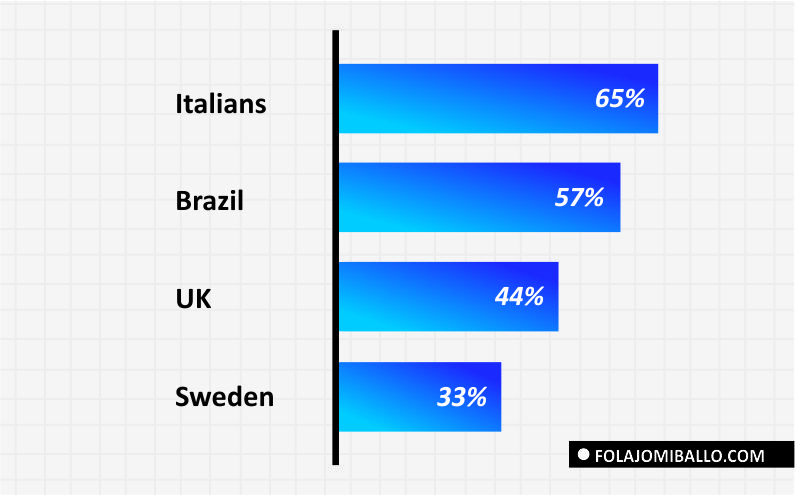
The way customers in different regions emotionally connect with brands is different. A study shows that Italians emotionally connect the most with brands (65%), followed by Brazil (57%). The third spot goes to the UK (44%), and Sweden makes the last spot for most highly emotionally engaged with brands (33%).
12. Subconscious factors determine 95% of purchase decisions
The best strategy for marketing products to customers is to target their subconscious minds. You want to touch that part your customer has no control of.
According to a study, 95% of purchase decisions are determined by subconscious factors. The most significant subconscious factor that partakes in the buying decision is emotion. How you make a customer feel about your product will determine if they will buy or not.
Emotion is what really drives the purchasing behaviors and also the decision-maker.
Luxury goods are a good example. It targets our self-worth and status globally, so we are compelled to buy them to feel among the high class.
Read Also: Best Free 60 day Web Hosting Trial
Wrapping Up
Emotional marketing has evolved and has proven to be an effective marketing tactic with high conversion. Brands that understand how to get into the emotion of their target customers will surely build loyal customers over time.
There’s a lot to learn from these emotional marketing statistics. Weaving emotions into your business strategy is a powerful technique to encourage your customers to resonate and act as you wish.
Using emotions in marketing means knowing your audience and understanding the emotions that will likely resonate with them. When you put these things together, you can easily win over their emotions and make them engage with your brand.
Which of these emotional marketing trends do you find interesting?
More:

What are the sources of these stats?
I linked to the sources above.